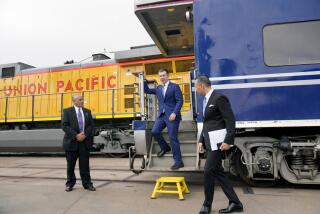Gov. Brown asks President Trump for help on the California bullet train

Gov. Jerry Brown on Friday appealed to President Trump for help on the California bullet train, which would connect Los Angeles and San Francisco.
Brown’s letter asks the president to transfer federal oversight of environmental reviews on the $64-billion project to the state rail authority.
It also seems to search for common ground between two leaders who have little other than an appreciation for high-speed rail and a disdain for what some would call “red tape.”
Brown has made the construction of a bullet train a cornerstone of his vision for the state’s future transportation system, while Trump has touted the need for fast trains nationwide.
So far, Brown hasn’t gained any demonstrable traction with the Trump Administration, but the letter appears to be his biggest bet yet that he can do business with the president — even while the Trump administration battles California over sanctuary cities and other hot-button issues.
Brown’s request for “delegation of federal authority” under the National Environmental Protection Act is far from symbolic.
The bullet train project’s environmental review process is behind schedule. Earlier this year, the state’s rail authority said it would not meet its long-stated goal to have all of its reviews done this year and that they would slip into 2018.
“The authority has had ongoing discussions with the administration about streamlining the environmental process,” rail authority spokeswoman Lisa Marie Alley said in an email Friday.
Brown made his request because he believes the state can handle the environmental workload faster than federal regulators, according to officials close to the project.
The rail project is broken into a series of regional segments for environmental review, each requiring the designation of routes, station locations and many other matters.
Teams of state consultants prepare the massive documents that the rail authority board submits to the Federal Railroad Administration for final approval.
The two segments in the Central Valley that have completed reviews so far were amended to leave out the most complex parts, including how the bullet train would go through Bakersfield and how it would complete a complex rail junction north of Madera.
Those reviews have been subject to a number of amendments, each of which must be forwarded to the Federal Railroad Administration for approval.
Alley said those amendments are not extensive. But Elizabeth Alexis, co-founder of a Bay Area group that has been a longtime critic of the project, said many parts of approved environmental documents have undergone revisions and must pass through federal regulators, which causes delays.
Brown is seeking to shortcut that process so that the rail authority board makes the final decision on the reviews and the changes.
In his letter, he tells Trump that getting waivers from federal environmental oversight has allowed California to “cut the regulatory burden on thousands of road projects.”
And he noted that Trump’s own White House Council on Environmental Quality has outlined a process to expedite such reviews.
Several years ago, Brown had discussed putting the rail project on a “fast track” approval process for environmental review, similar to the abbreviated procedures that are sometimes granted to such projects as sports stadiums.
But environmental groups opposed watering down environmental protections even while supporting the bullet train.
The state’s Republican delegation in the House has sought to initiate a major financial audit of the project and delay funding.
Evan Westrup, Brown’s press secretary, reminds that Brown, in his state of the state speech, remarked on this potential common ground with Trump.
“Gov. Brown specifically noted infrastructure, including construction of the High Speed Rail, as an area ‘where we can all work together.’”
Brown’s letter, Westrup said, “Lays out how we can do that.”
How much the environmental approval switch could help the troubled rail project is unclear in the face of a lack of money and multiple delays.
The issue with the environmental reviews and how to expedite them goes a long way back.
In 2014, the rail authority sought and received approval from the federal Surface Transportation Board, an independent federal agency that regulates railroads, for an exemption from the California Environmental Quality Act.
CEQA is generally more stringent than its federal counterpart law. After obtaining the approval, however, the rail authority decided to comply with both state and federal environmental laws.
Alley said the decision on whether to delegate authority on environmental decisions to the state rests with the secretary of Transportation, Elaine Chao. Earlier this year, Brown met with Chao.
The substance of the meeting was never made public, but officials close to Brown said the meeting went well.
Twitter: @rvartabedian
More to Read
Sign up for Essential California
The most important California stories and recommendations in your inbox every morning.
You may occasionally receive promotional content from the Los Angeles Times.






